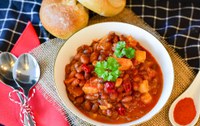Prairie Fare: Is your evening meal “dinner” or “supper”?
(Click an image below to view a high-resolution image that can be downloaded)
When I was in grade school, I used to walk the short distance home for dinner around noon. After school, I was really hungry, so I had lunch at 3 p.m. About 6 p.m., we had supper.
When I went away to college, I began referring to “dinner” as “lunch” and “supper” as “dinner.”
My family thought I had turned in to a “city slicker” with my change in the names of our meals.
After all, we had a supper club in the next town, and church suppers drew a large crowd.
“Breakfast” was always named breakfast, though. Sometimes, however, we would have “lunch” between breakfast and dinner. Now, the lunches would be considered “snacks.”
I suggested having “brunch” as a meal between breakfast and lunch. I was really “highfalutin” with that eye-rolling term.
What did you grow up calling the midday and evening meals? The names of meals vary a bit depending on where you grew up and how old you are.
Years ago, most people were doing more physical work than many of us do now. People needed to keep their energy levels high if they were outside doing farm work, for example.
Where did the various meal names originate? Was this a Midwest term or a small-town phenomenon?
Traditionally, dinner was the largest meal served in the middle of the day, and supper was a lighter meal served in the evening. Dinner was a more formal, complete meal.
The historians at Merriam Webster Dictionary provide some context for the names of our meals.
“Dinner” comes from a Middle Eastern word meaning “to dine” while “supper” comes from an Anglo-French word meaning “to sup.” “Sup” sounds like “soup,” and a pot of simmering soup was a welcome lighter meal in the evening.
The names of our meals evolved with the changes in society. As more people began working a distance from their homes, having a large noon meal with family was not very practical. The evening meal became the heavier meal and was known as “dinner.”
Whatever you call your meals, eating a variety of healthful food regularly is important for all of us. Finding time for meal preparation can be a challenge for some, regardless of the time of day the meal is served. Which of these time-saving tips do you use?
- I plan menus and write grocery lists, so I have meal ideas and the food I need.
- I sometimes prepare portions of a meal in advance.
- I sometimes use leftovers as the basis for another meal.
- Other people in my household help with meal preparation and cleanup.
- I focus preparation efforts on one portion of the meal. For example, if the main course is time-consuming, I fix a simple vegetable or salad.
- I assemble equipment, cooking utensils and ingredients before I begin meal preparation.
- I use time-saving equipment, such as slow cookers and microwave ovens.
- I use the one-pot method. For example, I add vegetables to pasta that is cooking.
For more information, visit www.ag.ndsu.edu/food and click on “Meal Preparation.” Check out our free monthly e-newsletters too.
Looking for tasty recipes? I plan to give away at least 25 copies of our 2023 calendar based on random drawings by Nov. 25. This colorful calendar includes recipes, tips and information to explore.
To enter the drawing, visit bit.ly/PrairieFare-drawing and answer the questions. If the link does not work for you, please email me at julie.garden-robinson@ndsu.edu with “Calendar Drawing” as the subject. Please provide a topic of interest and your complete mailing address for a chance to win a free 2023 calendar.
Here’s a quick recipe that can become the basis for a second meal when served with baked potatoes topped with cheese.
30-minute Chili
½ cup chopped onion
½ pound lean ground beef
2 teaspoons chili powder
pepper (to taste)
1 can (16 ounces or 2 cups) tomatoes, plain or stewed
1 can (8 ounces or 1 cup) tomato sauce
1 can (15 ounces or 2 cups) kidney beans, undrained
Optional add-ins (potato chunks, corn, peppers)
Chop the onion. Brown the ground beef and onion in a pot. Skim the fat. Stir in the rest of the ingredients. Heat for 10 to 15 minutes and serve. Leftovers can be used to top baked potatoes.
Makes four servings. Each serving has 230 calories, 3.5 grams (g) fat, 20 g protein, 30 g carbohydrate, 8 g fiber and 540 milligrams sodium.
(Julie Garden-Robinson, Ph.D., R.D., L.R.D., is a North Dakota State University Extension food and nutrition specialist and professor in the Department of Health, Nutrition and Exercise Sciences. Follow her on Twitter @jgardenrobinson)
NDSU Agriculture Communication – Oct. 27, 2022
Source: Julie Garden-Robinson, 701-231-7187, julie.garden-robinson@ndsu.edu
Editor: Elizabeth Cronin, 701-231-5391, elizabeth.cronin@ndsu.edu




